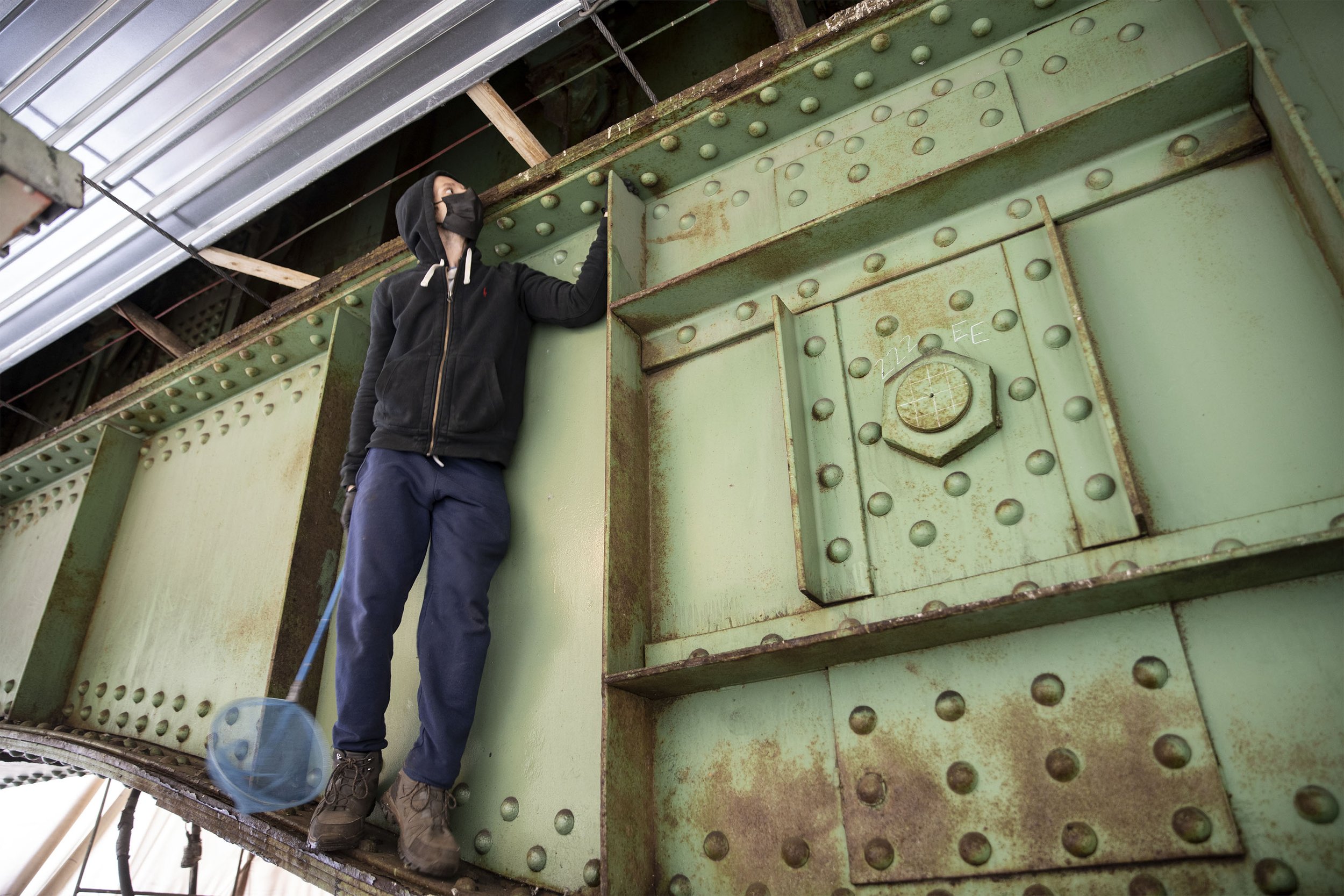
The Pigeon Rescuer of the Gowanus Expressway
Text and Photos Hongyu Liu
Pedestrians and drivers passing through Sunset Park’s Third Avenue may not notice Kelvin Diaz as he climbs stories high on wobbling scaffolding covered with layers of plastic wrap onto the pillars of the Gowanus Expressway bridge. As he ascends, the bridge shakes with traffic, emitting loud clunks of metal hitting metal.
“Sometimes when a truck passes by, I feel like the bridge is falling on me,” Diaz said.
He’s not a thrill seeker, but he is on a mission. Inside the bridge, adult pigeons and newborns are dying and Diaz is going to save them.
Pigeons fly next to the Gowanus Expressway. Photo Hongyu Liu
In August 2022, preparation started on the Gowanus Expressway renovation project to replace deteriorating components and repaint the 4-mile-long stretch of highway that runs through Sunset Park.
Almost immediately after the work, Diaz noticed pigeons were being trapped inside the bridge. “I knew then that it was going to have a significant impact on all birds living in Gowanus,” Diaz said.
Diaz, who grew up in Sunset Park, said he has "a big passion for all birds." While he shares his home with a pet parrot, he has also visited the pigeons near the bridge daily. Diaz has been feeding them and removing nets from their feet when they become trapped.
He deeply admires these birds, citing their intelligence and ability to survive even in harsh environments. He believes pigeons are often mistreated and looked down upon, which has motivated him to act. Unfortunately, others have been attempting to deter the pigeons from the area, with one individual going so far as to pour engine oil into the seeds Diaz had left out for the birds.
Diaz seals his protective suit with duct tape. Photo Hongyu Liu
Diaz said that the construction team came at night and used wooden planks to block the holes in the bridge pillars where pigeons were nesting, trapping them in a contained space with no access to light or food. Other pigeons were unable to find their way out due to tarps blocking their escape routes.
As a result, the pigeons can become trapped for weeks, often dying from starvation or dehydration.
“They were being ambushed,” Diaz said.
Diaz climbs up the scaffolding looking for trapped pigeons. Photo by Hongyu Liu Newborn pigeons in a nest on the Gowanus Expressway bridge pillar. Photo by Hongyu Liu
The construction company subcontracted to perform the blasting and painting job, Champion Painting Services Corp, isn’t trying to hurt the pigeons. On one occasion workers even helped Diaz rescue a bird perched too high for him to reach. But the company has its own safety protocols and must install the barricades in order to prevent lead paint dust from spreading beyond the site.
Diaz inside a construction site at the Gowanus Expressway. Photo Hongyu Liu
Still, Diaz hopes that the construction team can provide an escape route for the pigeons. Leaving a gap between the tarps can help.
“It is difficult because they have so many people with different opinions,” Diaz said.
Pigeons rescued by Diaz from the Gowanus Expressway. Courtesy of Kelvin Diaz
Diaz estimated that he had rescued over three hundred birds since August. He freed healthy adults once he got them outside the tarps. However, about half of the pigeons he rescued were newborns or young birds that had not yet learned how to fly or feed themselves. Some others were dehydrated and starved, needing further treatment to recover.
He’s brought more than fifty birds to the Wild Bird Fund, the only wildlife rehabilitation center in Manhattan since the beginning of 2023. But the fund is “completely overwhelmed” said Catherine Qualye, the social media director of the WBF, and asked Diaz to only bring in newborns or injured birds.
The Fund is equipped to treat around 250 to 300 animals at once, but they already have approximately 350 animals before the nesting season of other birds begins from April to August.
Diaz feeds corn and peas to a rescued pigeon. Photo by Hongyu Liu
Pigeons that Diaz rescued from the Gowanus Expressway. Photo Hongyu Liu
Since pigeons are not protected by federal law, no rehabilitator license is required to take care of them. Refusing to give up, Diaz drove as far as Yonkers and Long Island to drop off healthier pigeons to local volunteers who can take care of them.
Eugene Oda, a local rehabilitator, offered his insights and taught Diaz how to take care of the pigeons before volunteers could take them in. Starting from Apr. 16, they gather at a small community garden in Manhattan on Sunday afternoons. Oda laid out his cages, scales, and some corns, showing Diaz step by step how to feed the nestlings and treat them for common diseases.
“It takes commitment and some craziness to become a rehabilitator,” Oda said. “I see it in you.”
Diaz posters to inform workers about the pigeons. Construction area at the Gowanus Expressway. Diaz walks under the Expressway A pigeon looks on as Diaz leaves. Photos Hongyu Liu
Diaz plans to keep on his rescue mission until the end of the construction. Still, he finds the number of pigeons overwhelming.
“It’s hard to play the superhero, doctor, and transport all at the same time,” he said. “I just want to see the flocks again after the renovation.”
A pigeon rests in the bridge pillar inside the Gowanus Expressway. A view of Sunset Park from inside the Gowanus Expressway construction. Pigeons fly past the Expressway. Photos Hongyu Liu














